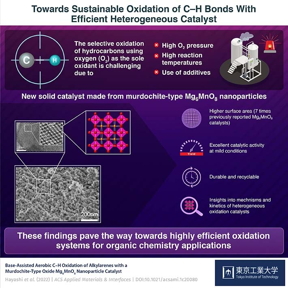Home > Press > Reusable Catalyst Makes CH Bond Oxidation Using Oxygen Easier and More Efficient
 |
Abstract:
The selective oxidation of CH bonds using oxygen has become a much simpler and more sustainable endeavor, thanks to a novel manganese (Mn)-based catalyst developed by scientists at Tokyo Institute of Technology (Tokyo Tech). Consisting of reusable Mg6MnO8 nanoparticles with unprecedented surface area, their catalyst enables the desired oxidative reactions to occur at mild temperature and pressure conditions without the need for toxic additives, opening doors to more energy-efficient and environmentally friendly chemistry applications.
Reusable Catalyst Makes CH Bond Oxidation Using Oxygen Easier and More Efficient
Tokyo, Japan | Posted on February 11th, 2022
In the chemical industry, the selective cleavage and oxidation of carbonhydrogen (CH) bonds, called “oxidative CH functionalization” is an essential step in the production of many solvents, polymers, and surfactants, as well as intermediate compounds for agrochemicals and pharmaceuticals. Ideally, one would want to use oxygen (O2) as the only oxidant in this process to avoid using more expensive and environmentally taxing substances, such as hydrogen peroxide (H2O2), chlorine (Cl2), or nitric acid (HNO3).
However, using O2 as the oxidant entails some unresolved problems. While some progress has been made in the field of recoverable and reusable catalysts, most heterogeneous systems require high reaction temperatures, high O2 pressures, or the use of toxic additives. In turn, this cripples the scope of potential applications, scalability, and efficiency of these catalytic systems.
Against this backdrop, a team of scientists from Tokyo Tech, led by Associate Professor Keigo Kamata, recently found a promising catalyst for oxidative CH functionalization. As explained in their paper published in ACS Applied Materials & Interfacesouter, they inferred that isolated manganese (Mn) species fixed in a crystalline matrix could constitute a high-performance heterogeneous catalyst even at mild reaction conditions, based on previous knowledge.
Accordingly, they investigated the catalyst murdochite-type Mg6MnO8, a rock salt structure of magnesium oxide (MgO) with one eighth of the Mg2+ ions replaced with Mn4+ ions and another eighth replaced with vacancies, resulting in a crystal with Mn ions and vacancies orderly occupying alternating layers. Using a cost-effective solgel method aided by malic acid, the team prepared Mg6MnO8 nanoparticles with a very high surface area. Dr. Kamata elaborates: “The specific surface area of our Mg6MnO8 catalyst was 104 m2/g, about seven times higher than that of Mg6MnO8 synthesized using previously reported methods.”
The researchers also demonstrated, through numerous experiments, that their Mg6MnO8 nanoparticles could efficiently catalyze the selective oxidation of CH of various alkylarene compounds even under mild reaction conditions, namely 40°C and atmospheric pressure. The yield of the final products was also higher than that obtained using existing Mn-based catalysts. To top things off, the Mg6MnO8 nanoparticles could be easily recovered via filtration and then reused without any apparent loss in catalytic activity after multiple cycles.
Finally, the team sought to understand why their proposed catalyst performed so well through a series of kinetic and mechanistic studies. They concluded that the isolation of redox sites (Mn species, in this case) in a crystalline base matrix (MgO) was a particularly important feature to achieve oxidative CH functionalization using O2 at mild conditions.
Satisfied with the results and their findings, Dr. Kamata speculates: “Our approach constitutes a promising strategy for the development of highly efficient heterogeneous oxidation systems with wide substrate scopes.”
Let us hope this study paves the way to more efficient and environment-friendly catalysts for organic chemistry applications.
####
Contacts:
Corresponding authors’ emails: ;
Further Information
Associate Professor Keigo Kamata
Institute of Innovative Research, Tokyo Institute of Technology
Contact
Public Relations Division, Tokyo Institute of Technology
Email
Tel +81-3-5734-2975
Copyright © Tokyo Institute of Technology
If you have a comment, please Contact us.
Issuers of news releases, not 7th Wave, Inc. or Nanotechnology Now, are solely responsible for the accuracy of the content.
Chemistry
![]()
Copper doping enables safer, cost-effective hydrogen peroxide production February 11th, 2022
News and information
![]()
NGI advances graphene spintronics as 1D contacts improve mobility in nano-scale devices February 11th, 2022
![]()
University of Oklahoma scientists quantum technology work garners international attention February 11th, 2022
![]()
Wise-integration and EDOM Technology Announce Channel Partnership for GaN IC Power Semiconductor Deployment February 11th, 2022
![]()
Polymer fibers with graphene nanotubes make it possible to heat hard-to-reach, complex-shaped items February 11th, 2022
Possible Futures
![]()
Scientists use DNA to assemble complex nanomaterials: Researchers create DNA nano-chambers with bonds that can control the assembly of targeted nanoparticle structures February 11th, 2022
![]()
NGI advances graphene spintronics as 1D contacts improve mobility in nano-scale devices February 11th, 2022
![]()
Polymer fibers with graphene nanotubes make it possible to heat hard-to-reach, complex-shaped items February 11th, 2022
Discoveries
![]()
Eyebrow-raising: Researchers reveal why nanowires stick to each other February 11th, 2022
![]()
Quantum tech in space? Scientists design remote monitoring system for inaccessible quantum devices February 11th, 2022
![]()
NGI advances graphene spintronics as 1D contacts improve mobility in nano-scale devices February 11th, 2022
Announcements
![]()
University of Oklahoma scientists quantum technology work garners international attention February 11th, 2022
![]()
Wise-integration and EDOM Technology Announce Channel Partnership for GaN IC Power Semiconductor Deployment February 11th, 2022
![]()
Polymer fibers with graphene nanotubes make it possible to heat hard-to-reach, complex-shaped items February 11th, 2022
Interviews/Book Reviews/Essays/Reports/Podcasts/Journals/White papers/Posters
![]()
Copper doping enables safer, cost-effective hydrogen peroxide production February 11th, 2022
![]()
Eyebrow-raising: Researchers reveal why nanowires stick to each other February 11th, 2022
![]()
Quantum tech in space? Scientists design remote monitoring system for inaccessible quantum devices February 11th, 2022
![]()
NGI advances graphene spintronics as 1D contacts improve mobility in nano-scale devices February 11th, 2022










